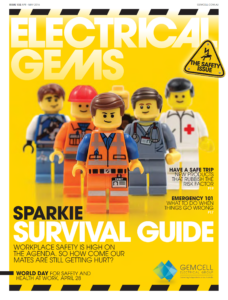Out Now
The Mental Health Issue
Current Issue
The Mental Health Issue
AUG - SEPT 2025

Weightlifting doesn’t mean bulking up like Arnie. But resistance training should be a part of your exercise routine. Here’s the lowdown.
If you think of greased-up models with pecs of steel when you think weight lifting, then think again.
Because weight training has become a hugely important component in the fitness routine of men and women across the world.
And today, it’s the domain of people of all shapes and sizes, as opposed to just the 20-something boys who spend more time at the gym looking in the mirror than they do working out (although you’ll still find these out and about in the wild).
Weight training is when you’re using some resistance to train specific muscle groups. That resistance can come in many forms – those classic free weights (dumbbells, barbells, kettlebells), medicine balls (high-school classic), resistance bands, weight machines, or even your own body weight (think push-ups, pull-ups and squats).
There’s a load of health and well-being benefits to be realised by incorporating resistance training into your routine – and many of them will help you in day-to-day contracting work too.
Improved muscle tone and strength protect your joints, and it’s important to maintain flexibility and balance as you age.
It can prevent or control chronic conditions including arthritis, heart disease, back pain and depression, while it can also increase your sense of well-being.
Oh, and it can help you sleep better too.
What’s not to love?
The recommendation is you do strength-building activities at least twice per week, and each session should incorporate all major muscle groups – legs, hips, back, chest, core, shoulders and arms.
For beginners, you should include 8-10 exercises, two to three times per week, and you should change up your workout every 4-8 weeks to keep things fresh and avoid your muscles becoming complacent.
If you don’t want to hit the gym and work out by yourself, there are loads of gyms around that offer resistance and strength training, either mixed in with cardio exercise or as standalone strength classes. The likes of F45 and CrossFit build weights into their classes, so that could be a good place to start exploring.
Don’t look like a total noob thanks to our mini-guide to gingo (gym lingo).
1RM: This is your one rep max – meaning how heavy you can go on a single lift. Some workouts, for example, will be based on a percentage of your 1RM.
AMRAP: As many reps/rounds as possible.
Deload: A training week where you take it easier to reduce fatigue.
Reps: The number of repetitions of a particular exercise in one go.
RPE: Rate of perceived exertion – which is completely personal to you. If you’re asked to work at 7RPE, that would mean you’re working at 70% of what you perceive your maximum to be.
Sets: A group of reps. For example, four sets of five reps, would mean you are doing five repetitions four times, with a rest in between each set.
Keep up to date with our latest news and competitions by subscribing to our regular newsletter.

Issue 183
OCT - NOV 2024

Issue 182
AUG - SEPT 2024

Issue 181
JUN - JUL 2024

Issue 180
APR - MAY 2024

Issue 179
FEB - MARCH 2024

Issue 178
DEC 2023 - JAN 2024

Issue 177
OCT - NOV 2023

Issue 176
AUG - SEPT 2023

Issue 175
JUN - JUL 2023

Issue 174
APR - MAY 2023

Issue 173
FEB - MAR 2023

Issue 172
DEC 2022 - JAN 2023

Issue 171
OCT - NOV 2022

Issue 170
AUG - SEPT 2022

Issue 169
JUN - JUL 2022

Issue 168
APR - MAY 2022

Issue 167
FEB - MAR 2022

Issue 166
DEC 2021 - JAN 2022

Issue 165
OCT - NOV 2021

Issue 164
AUG - SEPT 2021

Issue 163
JUN - JUL 2021

Issue 162
APR - MAY 2021

Issue 161
FEB - MAR 2021

Issue 160
DEC 2020 - JAN 2021

Issue 159
OCT - NOV 2020

Issue 158
AUG - SEPT 2020

Issue 157
JUN - JUL 2022

Issue 156
APR - MAY 2020

Issue 155
FEB - MAR 2020

Issue 154
DEC 2019 - JAN 2020

Issue 153
OCT - NOV 2019

Issue 152
AUG - SEPT 2019

Issue 151
JUN - JUL 2019

Issue 150
APR - MAY 2019

Issue 149
FEB - MAR 2019

Issue 148
DEC 2018 - JAN 2019

Issue 147
OCT - NOV 2018

Issue 146
AUG - SEPT 2018

Issue 145
JUN - JUL 2018

Issue 144
APR - MAY 2018

Issue 143
FEB - MAR 2018

Issue 142
DEC 2016 - JAN 2017

Issue 141
OCT- NOV 2017

Issue 140
AUG - SEPT 2017

Issue 139
JUN - JUL 2017

Issue 138
APR - MAY 2017

Issue 137
FEB - MAR 2017

Issue 136
DEC 2016 - JAN 2017

Issue 135
OCT - NOV 2017

Issue 134
AUG - SEPT 2016

Issue 133
JUN - JUL 2016

Issue 132
APR - MAY 2016

Issue 131
FEB - MAR 2016

Issue 130
DEC 2015 - JAN 2016

Issue 129
OCT - NOV 2015

Issue 128
AUG - SEPT 2015

Issue 127
JUN - JUL 2015

Issue 125
APR - MAY 2015

Issue 125
FEB - MAR 2015

Issue 124
DEC 2014 - JAN 2015

Issue 123
OCT - NOV 2014

Issue 122
AUG - SEPT 2014

Issue 121
JUN - JUL 2014

Issue 120
APR - MAY 2014

Issue 119
FEB - MAR 2014

Issue 118
DEC 2013 - JAN 2014

Issue 117
OCT - NOV 2013

Issue 116
AUG - SEPT 2013

Comments (0)
Write a Comment